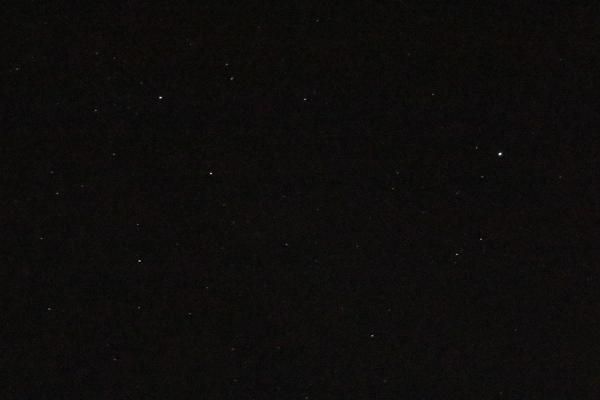Today was Rosh Hashanah– happy new year to those who celebrate it– meaning that both SteelyKid’s school and The Pip’s day care were closed. In an effort to maintain my sanity while keeping them entertained, I took them to the local science museum to rampage through hands-on exhibits. We also caught the planetarium show, because why not.
The show wasn’t really pitched right for my 7- and 3.8-year-olds, but it did make me wonder how the new camera would do at photographing the sky. And it’s pretty clear tonight, so here’s a shot of the sky more or less straight up at about 9pm Eastern:

This is a 30-second exposure (the longest setting available) with an 18mm lens (the wide-angle zoomed in all the way) and the ISO set to the maximum value of 12800. I cropped this down a bit because when I scaled the full field down to fit on the blog, you could barely see anything.
Just for kicks, here’s a 600×400 chunk from the full image, so you can see what you get without scaling the JPG:

You can see that the individual stars are stretched out a bit by the long exposure, but not ridiculously so.
So, anyway, the new camera’s pretty good.
Bonus interesting note: The star field I cropped down for these is image 1001 with the new camera. So in two weeks, I’ve taken over a thousand photos (most of these are near-duplicates, because I keep it in the rapid shooting mode, because kids, and the shutter rate is faster than with the old camera). New toys are fun!

To get more accurate images, I shoot RW2 (RAW) so that I don’t have squashed or stretched objects or artifacts caused by JPEG compression. This is particularly evident when shooting moons, stars, planets, landscapes and even faces. You can experiment by setting your camera to take both RAW and JPEG images of each shot. The differences will really show when you crop or do post processing.
Just out of curiosity any identifying constellations in that patch of sky? I’ve been trying to look through Stellarium at 9pm EST from NY… no luck yet..
The stretched stars are due to the earth’s rotation, not JPEG compression. The rough rule of thumb is that you can shoot at 1/focal length without noticeable stretching. But that’s for full-frame cameras; with a crop sensor, 18mm is getting close for a 30s exposure. And the stars do look fairly sharp until zoomed in to the pixel level.
Looks like Cygnus flying from upper left to lower right, and most of the rest of the summer triangle. Just missing Altair out of the bottom of the shot.
Oh, and the constellation on the right side of the photo is Lyra; the brightest star is Vega. It’s also in the zoomed shot. The constellation on the left of the photo Cygnus, including Deneb.
As far as the target region, I was, in fact, aiming for the summer triangle. The bottom of the image is vaguely south; there are power lines overhead on that side of the yard, so I angled the camera to miss them.
In the 600×400 pic, the really bright star is Vega. Next to it (to the left) you can see the star stretched in the opposite direction to Vega’s “stretch”. This star is Epsilon Lyrae, the famous “double double” star, and what you captured is the larger duplicity of this pair of pairs. So, nice shot for 30 seconds.
Plate solved!
http://nova.astrometry.net/user_images/808371#annotated
Although I’m not sure how long the results hang around online.